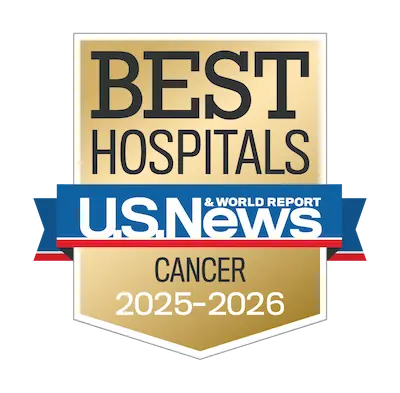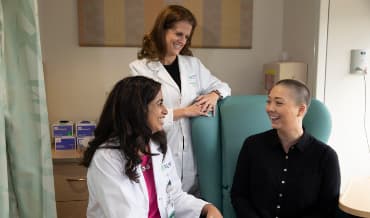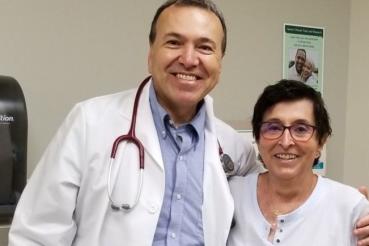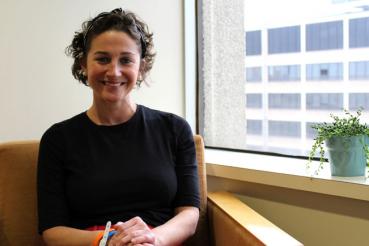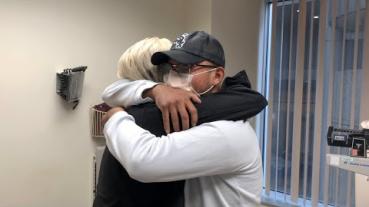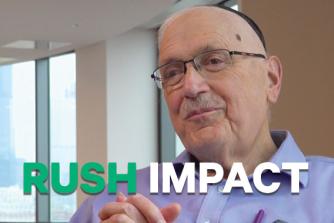A bone marrow transplant swaps faulty blood cells with healthy ones. All the blood in your body starts as a stem cell. These immature blood cells are present in bone marrow, the spongy center of your bones. If you have certain blood cancers or blood disorders, a stem cell transplant procedure can cure your condition.
A stem cell transplant can result in healthy bone marrow tissue and new, healthy blood.
The Rush Approach to Bone Marrow Transplant (BMT)
Bone marrow or stem cell transplant might be a lifesaving option if you have a blood cancer like leukemia or lymphoma that hasn't responded to standard treatment. It is also an option for a bone marrow disease such as amyloidosis or aplastic anemia, or another blood condition like sickle cell disease.
A bone marrow transplant uses stem cells collected from your own bone marrow (autologous transplant) or a donor's bone marrow (allogeneic transplant). A stem cell transplant uses cells from donor blood or your own blood.
Rush also offers cord blood transplants if you need a donor transplant but don’t have a match. To use donor cells, you and your donor have to be a close match — but cord blood doesn't require as close a match. Our use of cord blood means that no patient goes without a donor.
Rush University Medical Center was one of the first centers in Chicago to offer chimeric antigen receptor T-cell therapy (CAR T-cell therapy) for patients with certain types of leukemia and lymphoma. CAR T-cell therapy modifies your own T-cells to recognize and destroy cancer cells, enabling you to respond to chemotherapy and qualify for a bone marrow transplant.
Conditioning for Transplant
Chemotherapy and radiation are two cancer treatments. They work together to destroy the cancer cells in your body.
Chemo and radiation play a special role for people who need a stem cell transplant. The high doses of chemo and radiation used for cancer treatment kill your stem cells faster than your body can make them, meaning your body stops making any blood cells for a short amount of time. This is called “conditioning” and prepares you for a stem cell transplant. Sometimes, your doctor may use lower dose of radiation and chemo because of your age, overall health or your disease type.
A stem cell transplant “rescues” your bone marrow, replacing the stem cells that were destroyed by chemo and radiation. These new stem cells grow into healthy blood, free of cancer or disease.
If you have a stem cell transplant procedure that uses cells from a healthy donor, your new cells can also help you fight any residual cancer cells. Called the “graft-versus-cancer” or “graft-versus-leukemia/tumor” effect, the cells grown from donated stem cells find and kill cancer cells better than cells produced from your own body.
Types of Stem Cell Transplant
There are two main types of stem cell transplant:
- Autologous transplant: Your own stem cells are collected using a special machine (called an apheresis machine) before you get chemotherapy or radiation conditioning. Later, the stem cells are given back to you through a transfusion.
- Allogenic transplant: Stem cells are collected from a donor (who may be related or unrelated to you). Later, the stem cells are given to you through a transfusion.
The type of transplant that’s right for you depends on your disease. Your doctor will help you figure out the best option for you.
Rush Excellence in Bone Marrow Transplant at our Cell Therapy Center
- National accreditation: Our team provides the highest level of care in the safest way possible. We're fully accredited by the Foundation for the Accreditation of Cellular Therapy in recognition of our transplant program's quality and safety.
- Fast-track clinic: Our fast-track bone marrow transplant clinic is open 365 days a year. This clinic helps you transition from inpatient to outpatient care by providing post-transplant care, chemotherapy and CAR T-cell therapy infusions. Housed in the inpatient bone marrow transplant unit at Rush University Medical Center, the clinic is here for you if you experience any issues or side effects. This may allow you to have a shorter inpatient stay and avoid the emergency room later.
- Inpatient physical therapy gym: We have a dedicated physical therapy gym for bone marrow transplant recipients. Research shows that when patients who undergo bone marrow transplant participate in structured physical activity and exercise, they have better outcomes, less fatigue, improved endurance and overall improved quality of life.
- Expert, collaborative team: Our team includes experienced transplant physicians, fellowship-trained specialists and advanced practice providers who work only with stem cell transplant patients, providing you with focused, personal attention and ensuring seamless care.
- Quality of life: Making sure you have good quality of life as a transplant patient is our top priority. We don't focus only on your physical treatment — we also focus on the mental, emotional and social aspects.
- Research that's redefining the field: Our transplant specialists conduct clinical and translational research, including research on transplantation immunology that helps us continue to improve treatment options and long-term outcomes.
FAQs About Bone Marrow Transplant
During a bone marrow transplant, stem cells are collected directly from the bone marrow in the operating room while you're under general anesthesia. During a stem cell transplant, stem cells are collected from the bloodstream. A stem cell transplant happens while you're awake in a clinic using a special machine.
Even though the collection processes are different, the treatment goals are the same: remission from your disease, healthy bone marrow and healthy blood.
All blood cells in your body started out as hematopoietic stem cells, often just called stem cells. These immature cells can turn into red blood cells (that carry oxygen around your body), white blood cells (that fight infection and make up your immune system) or platelets (that help your blood clot).
Chemotherapy and radiation destroy your existing stem cells, meaning that your body can’t produce its own blood — a good thing when you have a blood cancer or other blood condition. A stem cell transplant (either using the patient’s own stem cells or from a donor) allows healthy, mature blood cells to be produced.
Bone marrow transplants and stem cell transplants are used to treat a wide range of problems, including:
- Leukemia
- Lymphoma
- Multiple myeloma
- Myelodysplastic syndromes
- Myeloprolipherative neoplasm
- Aplastic anemia and some other bone marrow failure disorders
- Some autoimmune diseases, including systemic sclerosis and multiple sclerosis
- Sickle cell anemia
- Some rare cancers including germ cell carcinoma and neuroblastoma
Every procedure has risks and benefits. The benefits of a stem cell transplant are treating your cancer or disease.
One of the big risks of stem cell transplant is infection. After your transplant, your body will take a couple of weeks to produce new white blood cells, your body’s natural defense system. During this time, you are at risk of severe infections (that wouldn’t be a problem for someone with white blood cells).
Your doctor will monitor you closely for signs of a problem. If you have a fever, talk to your transplant care team right away, as this is sometimes the only sign of an infection.
Another risk is bleeding and bruising. For weeks following a transplant, your body isn’t making platelets, the blood cells that help your blood to clot. Some people have mild issues, like bleeding gums and easy bruising. Others may need a red blood cell transfusion during their recovery.
Problems with your heart, lung, kidney or liver can sometimes happen, depending on your general health and the type of transplant you receive.
If you had a transplant from a healthy donor, graft-versus-host disease (GVHD) can be a problem. Many people have mild GVHD, especially soon after transplant. The most common symptoms are a rash, burning and redness on the palms of your hands and soles of your feet. Sometimes GVHD can be more serious, affecting your digestive system, liver or lungs. Your medical team knows what to look for and how to help.
Most people who have stem cell transplants are unable to have biological children. This infertility is a result of the high doses of chemo and radiation used before transplant. At RUSH MD Anderson Cell Therapy Center, we work closely with you to understand your goals for fertility preservation.
Prior to a bone marrow transplant, your team will work with you to improve your overall health. This may include nutritional, physical and emotional support.
Before the transplant, you will receive chemo and radiation. These come with their own side effects, risks and benefits. You’ll also have lots of medical tests (including blood tests and multiple imaging tests).
On the day of your transplant, you’ll get hydration and potentially some medications prior to the procedure. You’ll be awake during the transplant, and it doesn’t hurt.
The transplant is done like an infusion. The stem cells are infused by gravity using a central venous catheter, which is a special tube placed in a large vein. This is also used to give treatments like chemotherapy or to draw blood. The transplant could take as little as 20 to 30 minutes or as long as several hours.
We will keep an eye on you closely during the transplant procedure, looking for any signs of a reaction.
If you do have a reaction during the transplant, you may experience low blood pressure, high blood pressure, fever, chills, rash, hives, itching or pain. If this happens, we’ll give you medication to stop the reaction. Once your reaction stops, we’ll restart the transplant, usually infusing much more slowly to prevent another reaction.
The first six to 12 months are the most intense period of recovery.
For the first 30 days, you will be in the hospital or going to the outpatient clinic every day. We’ll be doing blood tests and monitoring you for any issues — and waiting for signs of a successful transplant.
Once you’re home and the transplant has been successful, recovery continues. You may feel very tired (fatigued). You’ll also be on medications to prevent infection. The exact recovery time for someone after a bone marrow transplant depends on how their body reacts and the type of transplant received.
Stem cell transplants can also have emotional side effects. Whether recovering in the hospital or at home, many people are affected by feelings of isolation and loneliness. You may be thrilled to have a new lease on life. You may feel discouraged at your pace of recovery. It’s important to have a good support system — including your team at Rush. We work with everyone who’s had a transplant to make sure they’re getting the emotional care they need.
Your medical team will find a donor for you. Usually, family members are tested for compatibility. If no match is found or if family members can’t donate, there are stem cell donor organizations that match willing stem cell donors with recipients.
We can also use umbilical cord blood as another source of stem cells for transplants. It can be used when a matched donor isn’t available, because it doesn’t require as close of a match as other types of transplants.
The first 12 months of recovery after a stem cell transplant can be difficult for patients and their families. Good medical care is just one part of a successful transplant — ongoing support is just as important for a successful recovery. Your care team will include physicians, nurses, pharmacists, psychologists, a chaplain, a dietitian, a social worker and a financial services team.
Our goal is to make this period as easy as possible for you. We celebrate milestones, help you manage your new medication routine and support you through any issues that come up.
Yes. Once your transplant is successful and you have recovered, you may even feel better than you did before the transplant. Many people celebrate their transplant day like a birthday, as it marks their new beginning.
Our autologous transplant survival rate is nearly 100%. For allogenic transplants, the survival rate is about 81% after the first year.
Yes. Our doctors are routinely involved in clinical trials. Talk to your care team about which trials might be right for you.
Caregiver support is essential for a successful transplant and recovery. From helping you get to appointments to managing your medication schedule, your caregiver will play a crucial role in your journey. Preparing for your transplant isn’t just about the medical side — it’s also about ensuring you have a strong support system in place. Having reliable help can make all the difference in your recovery and well-being.
After your first year, you may need checkups every six months to a year.
Yes. For patients with some types of cancers, immune effector cell therapy can treat your disease. This kind of therapy isn’t a stem cell transplant or bone marrow transplant. Instead, cells from your body’s own immune system are modified in a lab to fight cancer. Rush offers CAR T-cell therapy, TCR therapy and TIL therapy.
If you need immune effector cell therapy, you will have blood drawn and sent to a lab. At the lab, the cells will be changed at the genetic level. These changes give them the power to identify cancer cells and tell your body to destroy them. The genetically modified cells are then infused back to you.
Immune effector cell therapy can have serious side effects. We’re with you every step of the way, with a dedicated team that’s trained on how to care for patients like you. We’re also involved in researching how to use immune effector cell therapy in new conditions, so this treatment option can be available to more people.



